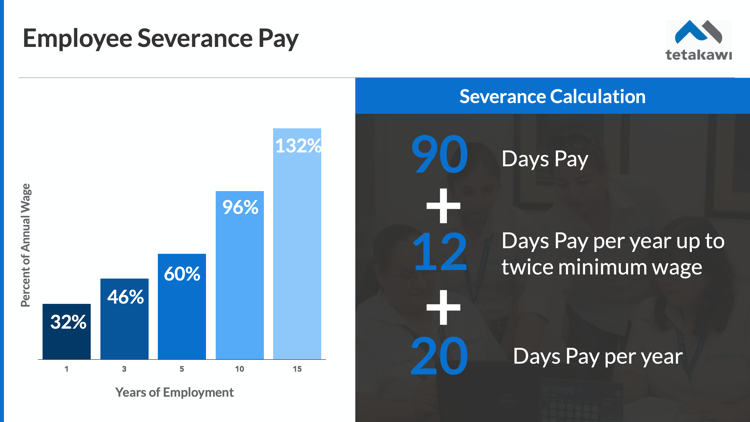Like most countries, Mexico protects workers who lose their job through no fault of their own. A combination of employment law and statutory severance entitlement helps employees weather a gap in their earnings. Understanding how these regulations affect hiring, scheduling, and termination in Mexico is critical.
A couple of constraints first, there are rules around temporary and permanent employment. Mexico does not permit temporary layoff and recall, which is a common tool for matching manpower to demand in many other jurisdictions. Another constraint is that there is no statutory probation period for workers hired on a permanent basis. They are immediately entitled to benefits.
There are also regulations defining the type of termination and the potential consequences for the employer. The federal government specifies the cost of severance and the circumstances in which it applies.
Temporary Contracts in Mexico
Employers can hire workers on a combination of temporary contracts for up to six months without the employee acquiring permanent status. Contract employees are not entitled to termination benefits. They are, however, entitled to compensation for the full term of their contract. This means you can hire someone on a 30-day contract and release them any time before the end of the contract by only paying the balance of the contract wages. You can keep renewing the contract as long as the temporary position does not last longer than six months. Contracts often work well for hourly labor where many candidates are unemployed at the time of hire. To attract anyone from another employer, the candidate will typically require an offer of permanent status.
One more consideration with temporary contracts is that employees reaching the end of six months with no permanent offer in sight are likely to seek other employment. Employers are wise to move at their earliest opportunity to convert temporary employees to permanent status.
Let’s suppose an employer hired an employee on a series of temporary contracts. After four months, they decide to bring her on full-time. What is she entitled to once she is a permanent employee?
First, if she resigns or abandons the employment of her own accord, she is not entitled to any settlement. A word of caution, though – employees have been known to abandon their employment and even take a job elsewhere and still successfully sue their former employer for termination without cause. It is crucial to follow appropriate due diligence and documentation to support an employer’s claim of voluntary resignation.
Second, She can be terminated with cause without any severance being due. However, governments prefer people to have jobs, so they set the bar for termination with cause quite high. Breaking a rule or poor performance is unlikely to meet the standard. Theft, violence in the workplace, intoxication at work, and other similar offenses are justifiable causes for termination with cause. Once again, caution is advised – the courts give the benefit of the doubt to the employee, so employers need solid evidence and preparation for the court to prove their case if the employee sues.
Every other form of termination is considered to be without cause, and the new employee will be eligible for severance benefits.
The Severance Process Explained
What happens if the employer terminates this new employee? =If he terminates her for cause or maintains that she voluntarily resigned, then she has a right to sue him in court. She can argue that the termination was not valid and the employer must prove his case. If the court finds or the employer agrees in advance that the employee was terminated without cause, then the law defines the amount of severance entitlement. With one minor exception, neither the employer nor the employee can alter the way severance is calculated.
The first entitlement is 90 days of pay at the employee’s most recent rate of pay. The rate of pay is the daily rate that is paid throughout the year. Everybody gets the 90 days entitlement to severance the minute they are permanently hired. The rest of their entitlement, however, depends on the length of service. Most benefits and taxes will apply, but bonuses are excluded.
For each year of service (partial years are prorated), an employee receives 12 days of pay at their most recent wage or twice the Federal Minimum Wage – whichever is less. They also receive 20 days of pay per year of service at their most recent wage with no limit on the amount.
In 2022, Mexico increased the minimum daily wage by 9% to 172.87 pesos ($8.25 USD) per day of work or 260.37 pesos ($12.43 USD) in the economic free zone along the northern border. There is no maximum number of years of service for either entitlement.
If there is no cause for firing an employee, the 90 and 12-day entitlements are due. There is no mitigation in the event that the employee finds another job. You simply pay the money, and the employee leaves.
The 20-day entitlement is a bit different. If an employer pays all the entitlements, including the 20 days, the employee loses the right to sue. However, if the employer pays the 90-day and 12-day amounts but less than the full 20-day entitlement, then the employee has the ability to sue for the difference. Since employees typically win, employers often simply pay the money.
However, it can be in the employer’s interest to negotiate with the employee. If a senior employee has been terminated for poor performance or other transgressions which have negative career implications, the employee will not want the details coming out in court or being otherwise broadly known. The employee may be willing to admit some liability and accept a lesser amount of severance. The law permits this type of agreement. For junior employees, it is not usually worth the effort, nor are they as likely to be concerned about the consequences.
Overview of Severance Calculation in Mexico

At the end of the day, most companies in Mexico manage severance costs within 2% to 3% of their payroll. This compares favorably with many other jurisdictions in the world where employers face unemployment insurance premiums or other termination costs.
When planning for severance costs in Mexico, it is good to remember that employees become entitled to severance as soon as they are permanently hired. Severance applies to any termination of employment except termination for cause and voluntary resignation by the employee. Termination for cause is hard to prove, and voluntary resignation must be documented.
Subscribe
Sign up and stay informed with tips, updates, and best practices for manufacturing in Mexico.





